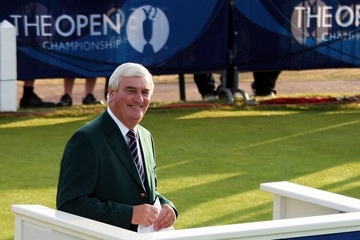
Written by Adam Schwartz
Any American golfer would pride themselves on winning their national championship, The U.S. Open. The U.S. Open prides itself on the setup of the host golf course. Shooting par is a great score to post as a player, and will usually give you an opportunity (unless you’re playing against Martin Kaymer this year) to win. Augusta prides itself on the tradition, condition, and rich history of the golf course. The PGA Championship is the final major of the year, and usually serves as the springboard to the Playoffs and either the Presidents Cup or Ryder Cup (depending on odd/even years).
 |
| Ivor Robson |
But there’s one magnificent tournament, known simply as the Open Championship, that stands alone. The U.S. Open has been held for 114 years; the Open has been played since before the Civil War. Golf’s oldest major championship has a few qualities which, in my opinion, set it apart from any other tournament:
1. It’s the only major where the course rotation encompasses strictly links-style golf courses in England, Scotland, and once, in Northern Ireland.
2. The Open is the only championship where a player could qualify on five different continents and/or in nine different countries.
3. The Open is the only major where you’ll see competitors hitting into pot bunkers on a consistent basis, and hitting the ball backwards to get out of these hazards.
4. The duel between Tom Watson and Jack Nicklaus at Turnberry in 1977, which became the benchmark of competitive golf and is widely known as one of the top sporting events ever played.
The Open will always have its rich history. Tradition is maintained. Courses like Augusta have been changed to become “Tiger-proof” and U.S. Open greens are tricked up, rolling at speeds that 99% of golf courses would never operate with unless they wanted to sod every six months, but the Open has character, and a constantly changing component that dictates the difficulty of each course: Mother Nature.
 |
| Nicklaus and Watson in 1977 |
Wind, rain, and existing conditions from weather patterns all dictate the results of this tournament, more than any other major championship. In 2009, 59-year-old Watson said, “I have a chance this weekend because of the forecast for the northeast wind … these young players have never seen a northeast wind at Turnberry; I have played in it.” Watson led 71 of the 72 holes, but lost in a four-hole playoff to Stewart Cink.
Unlike most tournaments, tee times begin only on hole #1. The Open will tee off players during the first two days for almost 10 hours straight. One of the iconic figures of the Open is starter Ivor Robson. If you’ve listened to an Open on TV in the past 40 years, chances are you’ve heard his voice announce the players for each match.
The 143rd edition of this timeless event will be held July 17-20 at Royal Liverpool in Hoylake, England. TV broadcasts begin at 2 a.m. Southern Utah time, but it’s worth staying up for. Whoever wins will need patience, a great caddy, and luck from Mother Nature.




